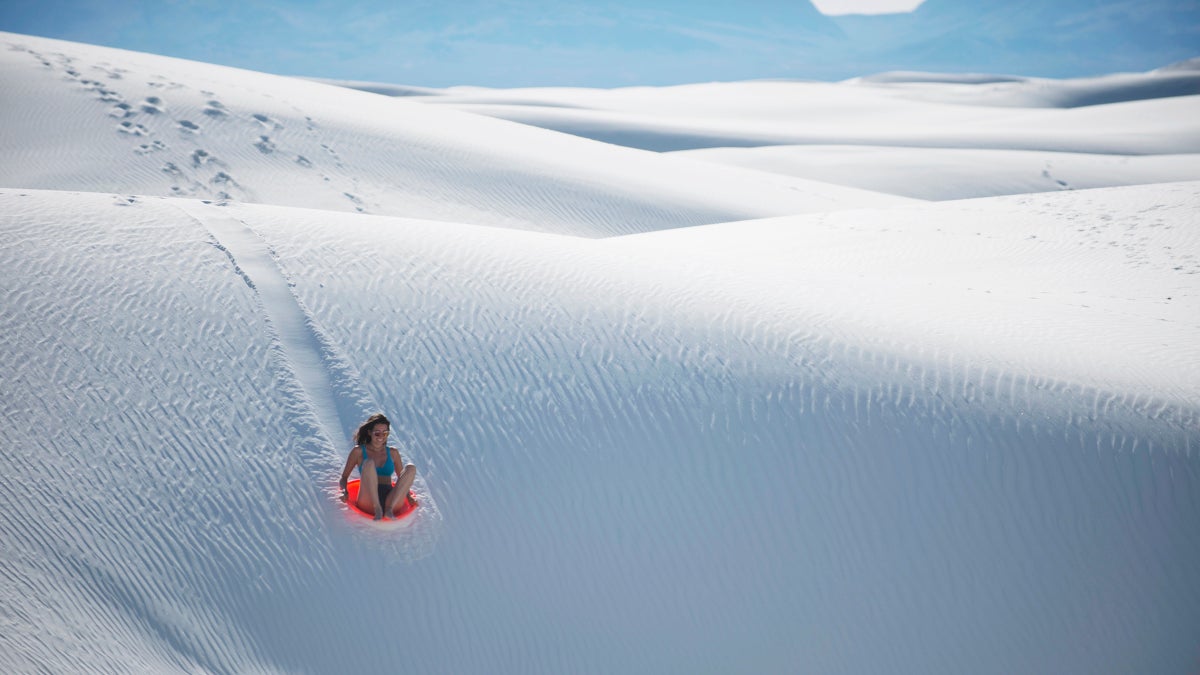
In your lifetime of small talk, you’ve probably been asked something like, “So, do you prefer the mountain or the beach?” Maybe you’re soothed by the sound of waves so you say beaches. Or maybe you prefer the smell of pine so you say mountains. But this classic speed-dating question doesn’t even consider a third option that offers the best of both worlds: sand dunes.
Formed by the wind over millions of years, sand dunes grow and shape shift as grains of sand erode and accumulate. These miraculous mounds are essentially mountains made of sand. The steep curve that the wind hits is called the slip face, and the back hump of the deposit is called the stoss side. Though they resemble peaks, walking on sand is not like walking on dirt or rock. The granules move as you step, providing less resistance and friction than a hard surface. This creates quite the workout in an otherworldly landscape ripe for outdoor recreation.
If you’re open to embracing sand in all your crevices and slowly gaining vertical as you hike to the crests, these five dune destinations across the U.S. offer a life-size sandbox for exploring.
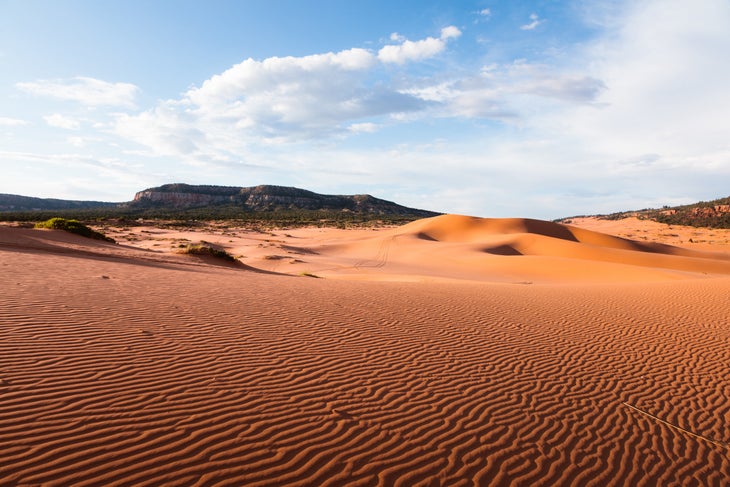
Coral Pink Sand Dunes State Park, Utah
Slightly north of the Utah-Arizona border, red rock country’s mineral-rich Navajo Sandstone crumbled away leaving behind 1,500 acres of coral-hued sand dunes. Over the course of a year, the landscape can change as much as 50 feet: Winds are funneled through a notch between the Moquith and Moccasin mountains, which increases wind velocity enough to carry sand grains from the eroding sandstone—a phenomenon known as the Venturi effect. These mounds have existed for 10,000 to 15,000 years as the only major dune field in the Colorado Plateau region.
Visit the state park at sunrise and sunset, when the sky and the sand contrast against each other to create a vibrant backdrop. Open during daylight hours for $10 per vehicle, about 90 percent of the park’s 3,730 acres welcomes four wheeling, and sections like the Natural Trail are reserved for hikers. Start at the observation deck and create your own path over the rippled surface. For a thrilling ride down the park’s two steepest faces, the visitor’s center offers sand sled rentals for $25 a day. Because the dunes are within driving distance from Zion and Bryce Canyon National Parks, make it a stop on a road trip through southern Utah.
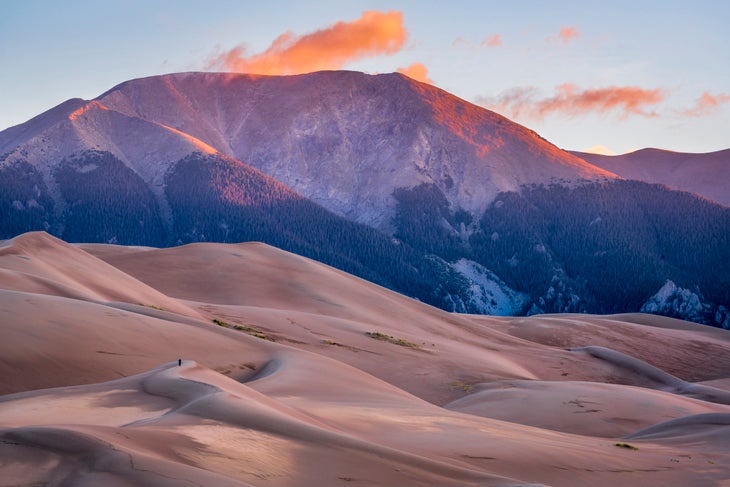
Great Sand Dunes National Park and Preserve, Colorado
North America’s tallest sand dunes are in southern Colorado, bordered by the Sangre de Cristo mountains. If you don’t already have an annual National Park pass, a $25 basic entrance pass is good for up to seven consecutive days. At their fullest, Star Dune rises 750 feet and High Dune crests at 700 feet. Once you exert maximum leg strength to reach their tops, you’re rewarded with panoramic views of the area’s peaks and valleys. During the warmer months, Medano Creek on the east side of the dune field fills with snowmelt, creating a beach-like atmosphere where kids and dogs splash around. Be forewarned: it gets crowded on weekends in late May and early June. Fall and winter are also magical seasons to visit, when a fresh dusting of snow coats the sand and rain hardens the surface to make sand easier to ascend.
Day-use activities include sand boarding and sledding. Just make sure to hit up retailers in town for rentals before entering the park (from $19 at Sand Dunes Recreation). At night, the stars and galaxies put on a cosmic show in this certified International Dark Sky Park. For a totally different view of the park away from crowds, snag a backpacking permit through recreation.gov ($6) to hike Sand Ramp Trail. With numerous camping areas along the route—the farthest is Sand Creek, 11 miles out and back—you can choose to stay in the dune fields or head into the alpine.
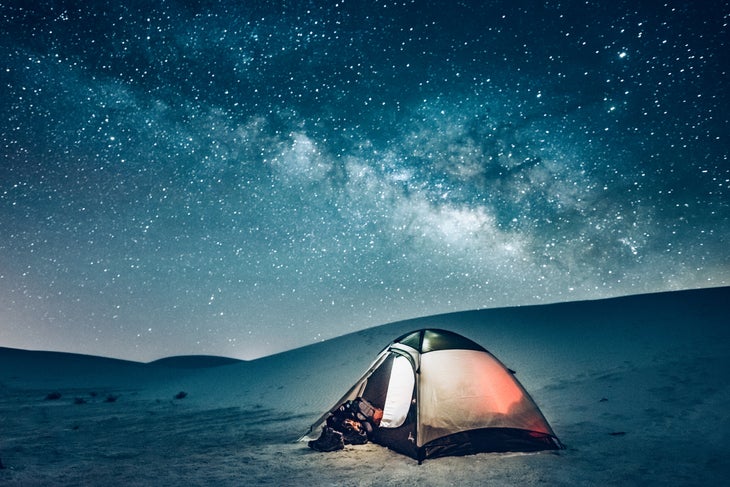
White Sands National Park, New Mexico
Designated in 2019, White Sands is one of the national park system’s newest sites. The $25 entrance fee is good for seven days, or you can use an annual National Park pass to enter. This great white pile of glistening sand covers 275 square miles of desert in the Tularosa Basin, making it the world’s largest gypsum dunefield. When rain and snowmelt wash minerals from the San Andres and Sacramento Mountains down to the basin floor, the water evaporates and leaves behind crystalline chunks. Hikers can see larger selenite crystals on the way to Lake Lucero.
Backcountry tent camping on the dunes is temporarily closed for rehabilitation, but you can find alternatives at Oliver Lee Memorial State Park in Alamogordo or Aguirre Spring Campground in Las Cruces. Immerse yourself in the pastel landscape on a number of day hikes ranging in difficulty. The 0.4-mile round trip Interdune Boardwalk is accessible for wheelchairs and strollers, while the Alkali Flat Trail takes you five miles over the dunes to the dry lakebed of Lake Otero. Like other stops on this list, sand sledding is allowed. Plastic saucers are for sale at the park’s trading outpost and gift shop ($25 for new, $20 for used, and $3 for wax). You can also bike or drive Dunes Drive, a 16-mile round trip scenic road that leads to wayside stops. (The first four miles are paved and the second four miles are hard-packed gypsum.) Tip: pack sunglasses for your visit because the sun-washed sand can be just as blinding as snow.
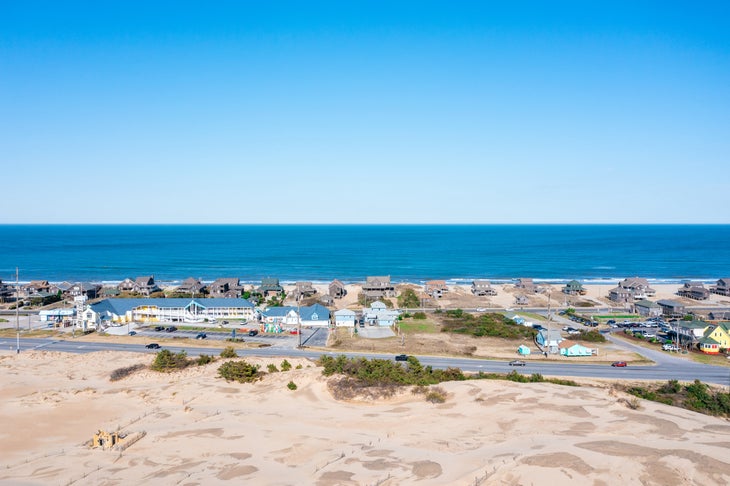
Jockey’s Ridge State Park, North Carolina
Starting 4,000 years ago, winds blowing in from the northeast in winter and from the southwest in summer have formed the East Coast’s tallest active sand dune system, often called “The Living Dune” for its constant evolution. Mostly made up of quartz rock granules, this special place in the Outer Banks is spread across 426 acres. The amount of sand is equal to about 6 million dump truck loads, according to the Friends of Jockey’s Ridge State Park. But the dunes are only one ecosystem of the park, along with the Maritime Thicket and Roanoke Sound Estuary. It’s free to enter from 8 A.M. to sunset every day but Christmas Day.
Strong and consistent gusts create ideal conditions for wind-related recreation, such as kite-flying from the ridgetops, windsurfing in the sound, and hang-gliding off designated dune faces. Kitty Hawk Kites offers rentals (including sand boards, boats, and beach gear) and lessons from their training center near the park’s visitor center. Looking for a slower-paced adventure? Several trails—like the Soundside Nature Trail, 360-foot Boardwalk Trail; or 1.2-mile Tracks in the Sand Trail—lead you through the different coastal environments.
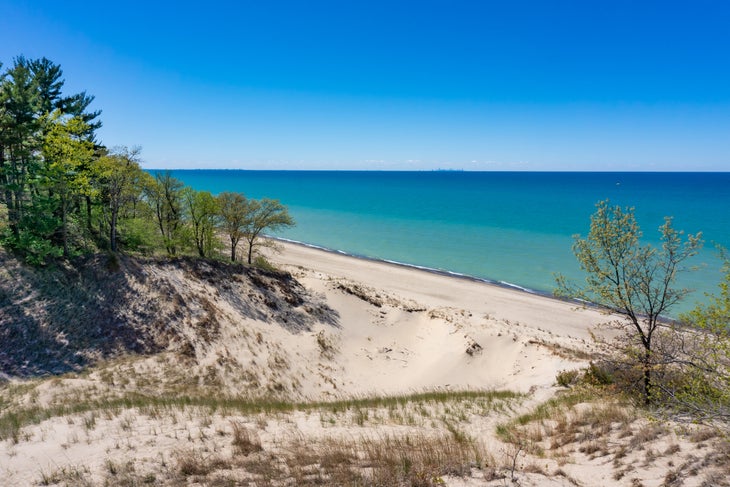
Indiana Sand Dunes National Park, Indiana
Towering nearly 250 feet high in some spots, Indiana Sand Dunes National Park’s glacial sand curves overlook Lake Michigan’s ocean-like expanse. The mighty lake has influenced the dunes and beaches over millennia, reshaping the topography with wind, waves, lake currents, ice, and storms. Today, with a $25 day pass or annual National Park pass, visitors can explore four major dune areas: Tolleston Dunes, Calumet Dunes, Glenwood Dunes, and the shoreline, which is considered the youngest dune complex. Wetlands fill the depressions between the ridges, and quiet woodlands, prairies, and savannas add greenery to the scenery.
This faux coastal area is a haven for hikers and beacon for birders with over 50 miles of trails through dunes, wetlands, prairies, and old-growth forests. The 4.7-mile Cowles Bog Trail is designated as a National Natural Landmark, and the 2.9 Tolleston Dunes Trail has a wheelchair-accessible route and an observation deck. Dogs are allowed at most locations in the park and can even earn their very own Bark Ranger tag at the visitor center. August is the perfect time to visit this national park, when the temperature ranges from a balmy 60 to mild 80.
The post The Best Sand Dunes in the U.S. appeared first on Outside Online.
